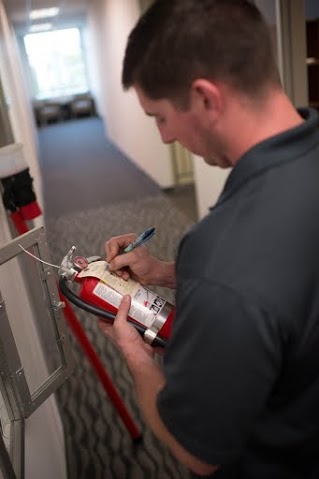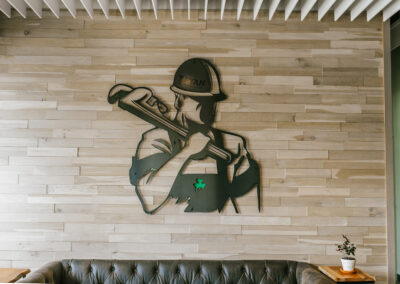
Quarterly and annual inspections are the two most common intervals for inspections and testing that Ryan Fireprotection conducts for its clients.
Quarterly inspections are basically visual inspections of equipment to determine that they are in operating condition and are free from physical damage. Alarms are also checked to see if they are working properly.
Annual inspections are both physical and visual. They are a more hands-on inspection and testing. While a quarterly inspection may involve checking a representative sample, an annual inspection involves inspecting everything and impacts every room.
The National Fire Protection Association’s standards (e.g., NFPA 25, 72, 10, 96, 20, etc.) have very specific requirements for what equipment needs to be inspected or tested and at what frequency. Some items need to be tested weekly, others monthly, quarterly, semiannually, annually, or after five years. See our
Visual Fire Sprinkler System Inspection Requirements article for an overview of the required schedule of inspections and testing.
When a company contacts Ryan Fireprotection for assistance in meeting the various inspections and testing requirements of NFPA, the state, or the local fire marshal, Ryan Fireprotection performs a comprehensive survey of all the facility’s fire alarms, water-based fire protection systems, kitchen hoods (if applicable), and life safety equipment. Using this information, Ryan Fireprotection drafts a service agreement to handle the needed inspections for all of the equipment.
Ryan Fireprotection service agreements normally cover the quarterly and annual inspections but can be tailored to the particular needs of each facility and building owner. For instance, if a facility doesn’t have the available staff, Ryan Fireprotection can perform the inspections that are required on a weekly or monthly basis. And, while not normally included in most service agreements, Ryan Fireprotection will inform its client when it is time for the five-year inspection.
With the many responsibilities that a building owner or facility manger faces each day, it can be difficult to keep track of what inspection is needed and when. Ryan Fireprotection uses software to keep track of inspections and will always call clients to schedule the next needed inspection or test. Below is a general guide to follow for annual and quarterly, visual and functional testing:
Quarterly Visual Inspections
Sprinklers, NFPA 25
- Waterflow Alarm and Signal Devices
- Valve Supervisory Switches
- Gauges (Wet Pipe Systems)
- Fire Department Connections
- Pressure Reducing and Relief Valves
- Hydraulic Design Information Sign
- Backflow Prevention Assemblies
Annual Visual Inspections
Portable Fire Extinguishers, NFPA 25
- All of monthly inspections, plus conductivity test (Carbon Dioxide)
- Determination of 6 year or Hydrotest, Inspection of shell and nameplate
- Hanger/seismic bracing
Sprinklers, NFPA 25
- Pipe and Fittings (from floor)
- Hangers/Seismic Bracing (from floor)
- Sprinklers (from floor)
- Spare Sprinklers
- Hydraulic Design Information Sign
- Information Sign
- Standpipe (Piping, Hose Racks, Hose Connections/Hose Valves, Hose/Hose Nozzles)
- Valves, Valve Components, Trim Inspections (Interior Dry, Deluge, Preaction, Pressure Reducing Valves)
- Private Fire Service Mains (Hydrants, Main Line Strainers)
E-Lights/Exit Signs, NFPA 101, 70
- 90 Minute drain test and inspection, verification of charge voltage, alignment of heads, hazard assessment, inspection sticker, required paperwork
Quarterly Functional Testing
Sprinklers, NFPA 25
- Mechanical Water Flow Devices
- Valves, Valve Components (Main Drain [with Backflow Device], Low Air Pressure Alarms, Quick Opening Devices, Priming Water)
Automatic Fire Alarm, NFPA 72
- Control Equipment-Building Systems Not Connected to Supervising Station (Functions, Fuses, Interfaced Equipment, Lamps/LEDs, Primary Power Supply, Transponders)
Annual Functional Testing
Portable Fire Extinguishers, NFPA 10
- Conductivity Test of All Carbon Dioxide Hose Assemblies. Ensure in Proper Operating Condition. Safety Seals, Tags, Pressure Gauge Reading, HMIS Label. Empty and Recharge All Stored Pressure Loaded Stream Fire Extinguishers.
Automatic Fire Alarm, NFPA 72
- Control Equipment-Building Systems Connected to Supervising Station (Functions, Fuses, Batteries, Interfaced Equipment, Lamps/LEDs, Primary Power Supply, Transponders)
- In-Building Voice/Alarm Communications Equipment
- All Initiating Devices (Smokes, Heats, Ducts, Manual Pull Stations, Carbon Monoxide, Etc.)
- Special Hazard Equipment
- Alarm Notification Devices (Horns, Strobes, Speakers, Chimes, Bells, Etc.)
- Mass Notification Systems and Components (Supervised)
Sprinklers, NFPA 25
- Main Drain
- Antifreeze Solution
- Valves, Valve Components (Pressure Reducing Valves/Relief Valves [part flow], Master Pressure Reducing Valves [full flow], Control Valves, Dry System, Partial Trip Test, Deluge, Preaction Full Trip Test, Air Maintenance Device)
- Backflow Prevention Assemblies (Full Forward Flow Test)
- Standpipe (Main Drain Test, Hose Valves, Valves [all types])
- Private Fire Service Mains (Monitor Nozzles, Hydrants)
- Fire Pump System (Full Flow, Alarm Signals, Annual Maintenance)
Contact Ryan Fireprotection to develop a schedule and service agreement that meets all the various inspection and testing requirements based on the equipment present as well as the resources of a particular facility.
 Quarterly and annual inspections are the two most common intervals for inspections and testing that Ryan Fireprotection conducts for its clients.
Quarterly inspections are basically visual inspections of equipment to determine that they are in operating condition and are free from physical damage. Alarms are also checked to see if they are working properly.
Annual inspections are both physical and visual. They are a more hands-on inspection and testing. While a quarterly inspection may involve checking a representative sample, an annual inspection involves inspecting everything and impacts every room.
The National Fire Protection Association’s standards (e.g., NFPA 25, 72, 10, 96, 20, etc.) have very specific requirements for what equipment needs to be inspected or tested and at what frequency. Some items need to be tested weekly, others monthly, quarterly, semiannually, annually, or after five years. See our Visual Fire Sprinkler System Inspection Requirements article for an overview of the required schedule of inspections and testing.
When a company contacts Ryan Fireprotection for assistance in meeting the various inspections and testing requirements of NFPA, the state, or the local fire marshal, Ryan Fireprotection performs a comprehensive survey of all the facility’s fire alarms, water-based fire protection systems, kitchen hoods (if applicable), and life safety equipment. Using this information, Ryan Fireprotection drafts a service agreement to handle the needed inspections for all of the equipment.
Ryan Fireprotection service agreements normally cover the quarterly and annual inspections but can be tailored to the particular needs of each facility and building owner. For instance, if a facility doesn’t have the available staff, Ryan Fireprotection can perform the inspections that are required on a weekly or monthly basis. And, while not normally included in most service agreements, Ryan Fireprotection will inform its client when it is time for the five-year inspection.
With the many responsibilities that a building owner or facility manger faces each day, it can be difficult to keep track of what inspection is needed and when. Ryan Fireprotection uses software to keep track of inspections and will always call clients to schedule the next needed inspection or test. Below is a general guide to follow for annual and quarterly, visual and functional testing:
Quarterly and annual inspections are the two most common intervals for inspections and testing that Ryan Fireprotection conducts for its clients.
Quarterly inspections are basically visual inspections of equipment to determine that they are in operating condition and are free from physical damage. Alarms are also checked to see if they are working properly.
Annual inspections are both physical and visual. They are a more hands-on inspection and testing. While a quarterly inspection may involve checking a representative sample, an annual inspection involves inspecting everything and impacts every room.
The National Fire Protection Association’s standards (e.g., NFPA 25, 72, 10, 96, 20, etc.) have very specific requirements for what equipment needs to be inspected or tested and at what frequency. Some items need to be tested weekly, others monthly, quarterly, semiannually, annually, or after five years. See our Visual Fire Sprinkler System Inspection Requirements article for an overview of the required schedule of inspections and testing.
When a company contacts Ryan Fireprotection for assistance in meeting the various inspections and testing requirements of NFPA, the state, or the local fire marshal, Ryan Fireprotection performs a comprehensive survey of all the facility’s fire alarms, water-based fire protection systems, kitchen hoods (if applicable), and life safety equipment. Using this information, Ryan Fireprotection drafts a service agreement to handle the needed inspections for all of the equipment.
Ryan Fireprotection service agreements normally cover the quarterly and annual inspections but can be tailored to the particular needs of each facility and building owner. For instance, if a facility doesn’t have the available staff, Ryan Fireprotection can perform the inspections that are required on a weekly or monthly basis. And, while not normally included in most service agreements, Ryan Fireprotection will inform its client when it is time for the five-year inspection.
With the many responsibilities that a building owner or facility manger faces each day, it can be difficult to keep track of what inspection is needed and when. Ryan Fireprotection uses software to keep track of inspections and will always call clients to schedule the next needed inspection or test. Below is a general guide to follow for annual and quarterly, visual and functional testing:
